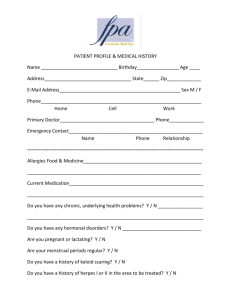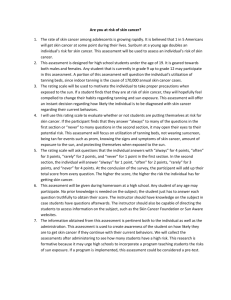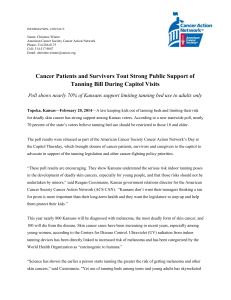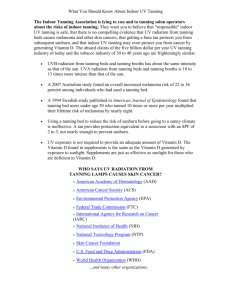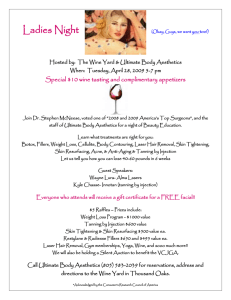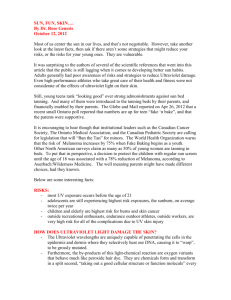Frequently Asked Questions
advertisement
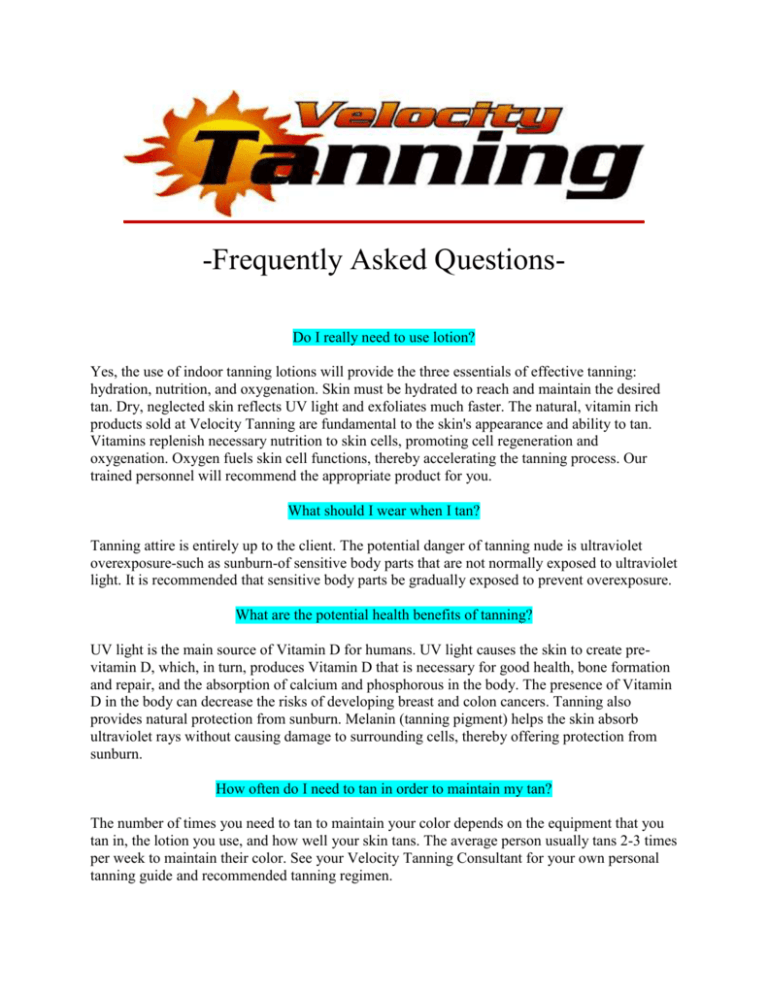
-Frequently Asked QuestionsDo I really need to use lotion? Yes, the use of indoor tanning lotions will provide the three essentials of effective tanning: hydration, nutrition, and oxygenation. Skin must be hydrated to reach and maintain the desired tan. Dry, neglected skin reflects UV light and exfoliates much faster. The natural, vitamin rich products sold at Velocity Tanning are fundamental to the skin's appearance and ability to tan. Vitamins replenish necessary nutrition to skin cells, promoting cell regeneration and oxygenation. Oxygen fuels skin cell functions, thereby accelerating the tanning process. Our trained personnel will recommend the appropriate product for you. What should I wear when I tan? Tanning attire is entirely up to the client. The potential danger of tanning nude is ultraviolet overexposure-such as sunburn-of sensitive body parts that are not normally exposed to ultraviolet light. It is recommended that sensitive body parts be gradually exposed to prevent overexposure. What are the potential health benefits of tanning? UV light is the main source of Vitamin D for humans. UV light causes the skin to create previtamin D, which, in turn, produces Vitamin D that is necessary for good health, bone formation and repair, and the absorption of calcium and phosphorous in the body. The presence of Vitamin D in the body can decrease the risks of developing breast and colon cancers. Tanning also provides natural protection from sunburn. Melanin (tanning pigment) helps the skin absorb ultraviolet rays without causing damage to surrounding cells, thereby offering protection from sunburn. How often do I need to tan in order to maintain my tan? The number of times you need to tan to maintain your color depends on the equipment that you tan in, the lotion you use, and how well your skin tans. The average person usually tans 2-3 times per week to maintain their color. See your Velocity Tanning Consultant for your own personal tanning guide and recommended tanning regimen. How often is a person allowed to tan? The Food and Drug Administration suggests that a 48 hour time period should pass between tanning sessions. Pigmentation and/or sunburn may not be fully visible for between 12-24 hours. Thus, two tanning sessions within a 24 hour period could cause an unintentional burn. In general, following the recommended exposure schedule and the recommendation of your Velocity Tanning Consultant will provide the best results. Can the UV rays emitted by indoor tanning lamps pass through the skin and affect internal organs? Although this is a popular myth, ultraviolet light waves cannot penetrate so deeply to affect the body's tissues and organs. Ultraviolet rays are not the same as X-rays or heat rays and, therefore, have different effects on the body. Overexposure will result in sunburn, but will not affect internal organs. Is it harmful to wear contact lenses when tanning indoors? It is not advised to wear contact lenses while tanning. Although wearing mandatory protective eyewear will protect your eyes from ultraviolet light. The heat generated could cause drying and discomfort. Why do some dermatologists warn people against sun exposure? While some dermatologists may advocate total avoidance of UV exposure, the media seems to quote only those who do. Many dermatologists and others from the medical community have acknowledged the need for moderate sun exposure, while advocating the use of sunscreens. Why do some people itch after tanning? Itching and/or rashes may be linked to several unrelated causes, so it is important to obtain a tanning history on each client. Some people are naturally photosensitive upon exposure to ultraviolet light. Others are susceptible to heat rashes, a cause totally unrelated to the UV exposure. Certain chemicals or ingredients found in cosmetics, lotions, shampoo, and even disinfecting agents may cause itching as well. Rashes caused by these products generally occur in localized areas on which the products were applied. It is advised to tan with the skin as clean as possible and to only use products approved or suggested by your tanning consultant. If discontinued use of a suspected product does not inhibit the problem, a person should discontinue any exposure to UV light until the condition subsides or visit a physician. What causes white spots? Tinea Versicolor, a skin condition that affects tanners, is caused by a microscopic fungus from the scalp. This fungus falls onto arms, shoulders, and other body parts and leaves bleached areas on the skin, which can spread. It is treatable and must be protected from further ultraviolet light exposure until those bleached areas have begun developing melanin again. Can indoor tanning cure acne? Phototherapy (use of UV light) has been effective in easing the skin problems common to this condition. There are also many drugs, including tetracycline and Retin-A, which are also widely used for the treatment of acne. Because these drugs can render the skin photosensitive, one must avoid UV exposure when medicated. Furthermore, the use of UV light for acne treatment should only be administered by a qualified physician. The Food and Drug Administration prohibits indoor tanning equipment operators from asserting that equipment use is beneficial for any purpose other than obtaining cosmetic coloring. Does tanning cause melanoma? There is no conclusive evidence which substantiates that malignant melanoma is caused by gradual, moderate UV exposure. However, those who are predisposed to develop melanoma due to hereditary factors may intensify this condition with exposure to indoor or outdoor UV light. While some studies have suggested a link between severe sunburn and malignant melanoma, there are other studies available that prove an inverse relationship. In a study published in the International Journal of Cancer in 1989 (known as the Western Canada Melanoma Study), Canadian researchers found a significant inverse association between melanoma and chronic or long-term occupational sun exposure in men, with the lowest risk in those with maximum occupational exposure. This may suggest that repeated exposure can be protective. Gradual, moderate exposure is not believed to be a strong influential factor as melanoma generally develops on those areas not normally exposed to UV light. Is it possible to contract AIDS and other sexually transmitted diseases from indoor tanning equipment? People cannot contract diseases from properly sanitized, well maintained tanning beds. Disease specialists have said that no evidence exists to prove that sanitized tanning units have spread diseases. Does tanning help treat depression or Seasonal Affective Disorder? There exists a growing body of scientific evidence which indicates that some people actually require more light exposure in order to function properly. Exposure to bright light, such as that emitted by the mid-day summer sun, causes the brain to suppress the release of the hormone melatonin. Melatonin acts as a depressant in the body if generated during the daytime. Thus, when affected people are exposed to longer hours of bright light, they feel happier, euphoric and more able to enjoy life. Bright light sources emitting only visible light are now frequently used to successfully treat Seasonal Affective Disorder (SAD) and Sub-syndrome Seasonal Affective Disorder (SSAD). Can indoor tanning equipment be used to treat skin disorders such as psoriasis? The F.D.A. and Federal Trade Commission forbid making representations regarding the benefits of indoor tanning other than its cosmetic effect. Therefore, one may not make medical claims about indoor tanning equipment. However, phototherapy (U.V. light treatment) can be used to ease the symptoms of psoriasis. The treatment is rendered by a trained physician with equipment specifically designed for such a purpose. Can tanning cause wrinkles? Excessive exposure can destroy the resilient fibers of the lower skin layer, thereby causing the top layer of skin to sag. Thus, elastosis or wrinkling appears. If UV light is not blocked by pigmentation in the outer skin layer, it can penetrate to the dermis and destroy skin elasticity. Thus, it is advised to avoid overexposure to ultraviolet light. May pregnant women tan indoors? Tanning indoors while pregnant is not permitted at Velocity Tanning. Medical professionals do not know how pregnancy is affected by the heat generated from tanning equipment. Also, a woman in advanced pregnancy could experience difficulty and discomfort using tanning equipment. Although, we do not permit pregnant women to tan, we are always more than happy to extend packages to be used after the child is born and suggest being spray tanned. Will I burn? Burning is the enemy. Tanning is your skin's natural defense mechanism and protection against burning. Burning leads to photo-damage, premature aging, sun-spots, drying, flaking and peeling of the skin, and should be avoided at all costs. At Velocity Tanning you can tan without burning. Tanning in moderation is the key to a beautiful tan and healthy glowing skin.
